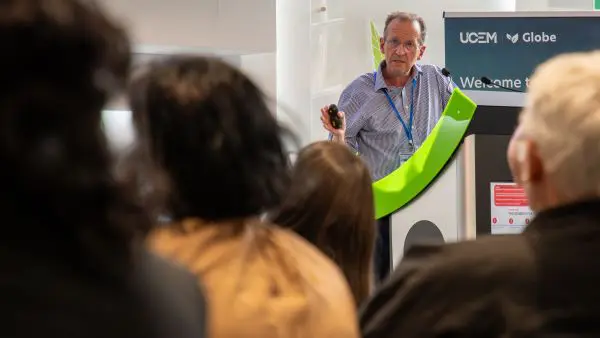UCEM INSPIRE: net zero building and biodiversity for a sustainable future
Posted on: 18 October, 2023

This article is the fifth in our series of posts covering our second INSPIRE event this summer. Read our previous piece on sustainability leadership here – UCEM INSPIRE: experts define built environment sustainability leadership.
UCEM’s recently held another of our UCEM INSPIRE events on the need for effective leadership in the quest for a more sustainable built environment.
The event was supported by the Construction Industry Council (CIC) and the Construction Leadership Council (CLC). It was run in partnership with the Edge, a built environment think-tank.
This in-person event brought together sustainability leaders and experts from leading organisations in the built and natural environment sector, including property owners, developers, designers, consultants, contractors and managers.
UCEM’s ‘INSPIRE’ events are themed sessions that enable collaboration between influential stakeholders to consider the various challenges facing the industry, bringing together INfluence for Skills, Productivity, Industry, Research and Education.
Across the day, a range of professionals with expertise in the built environment either participated as speakers or served as panellists. This article reviews the key points raised during speeches giving attendees updates on the Net Zero Carbon Building Standard and Biodiversity, both of which are crucial facets of a sustainable built environment.
Update Report 1: Chris Twinn
Net Zero Carbon Buildings Standard: A progress report
Chris Twinn, Net Zero Carbon Buildings Standard Governance Board Member and Principal, Twinn Sustainability Innovation, shared invaluable insights on the evolving Net Zero Carbon Building Standard.
Amid the growing popularity of sustainability, Chris lamented the widespread ‘greenwashing’. He championed genuine change, citing the UK Green Building Council’s roadmap as a beacon, though emphasising that much of the carbon reduction is not tied directly to buildings, but to broader infrastructure changes, like grid decarbonisation. Still, the need to reduce emissions from buildings is vital and the challenge is ensuring they genuinely contribute to the net-zero goal.
The task ahead is not vested in one organisation or individual. It demands collective industry collaboration. The Net Zero Carbon Buildings Standard’s (NZCBS) project team is made up of over 350 voluntary experts from all parts of the built environment industry. Their goal is. ultimately, a comprehensive ‘rulebook’ for assessing both new and existing buildings, ensuring consistent and effective measures for all in the sector.
Whilst the NZCBS is not a certification in itself, it is a foundational tool to understand the necessary steps towards net zero. The focus is not just operational; it extends to embodied and whole-life carbon. The NZCBS also recognises the intricacies of the building sector. For instance, the metrics for hotels differ drastically from offices or housing.
Learn more: Net zero carbon buildings explained: here’s why they matter
One core principle is transparency and accessibility to all. The NZCBS aims to be open to the whole industry, allowing everyone, including the small-scale players that comprise circa 78% of the property sector, to evaluate and adapt to new sustainable strategies.
Science is also central to the NZCBS. The project aligns with the 1.5-degree climate goal and scrutinises research, including from the Climate Change Committee. This approach factors in the carbon footprint of imported materials, which others typically overlook. Importantly, Chris noted that a critical part of achieving genuine change is to develop practical reporting mechanisms. If the process becomes too convoluted, we risk stagnation.
He finished with a set of thought-provoking questions. In a world rapidly decarbonising the energy grid, what does net-zero carbon truly mean at a building level? Will it demand new strategies and focuses, like addressing peak energy demands to prevent grid overloads? Furthermore, as the EU contemplates mechanisms to decarbonise materials, how does this affect the UK’s approach?
Update Report 2: Claire Neale
Biodiversity in the Built Environment – Challenges & Opportunities
Claire Neale, Service Line Director for Nature Based Solutions at Atkins, illuminated the critical intersections between biodiversity and the built environment.
Since the start of her career, when she was labelled a ‘tree hugger’, Claire witnessed a remarkable shift. Now, companies such as Atkins have seamlessly integrated natural environment and community considerations into projects from inception. This transformation echoes the broader societal evolution where understanding the significance of biodiversity has moved beyond just knowing that nature provides us a safe home, to realising that 55% of the world’s GDP relies heavily on nature.
Today’s challenges like climate change, overpopulation and overdevelopment require the built environment to be part of both the problem and solution.
However, the sector’s approach to these challenges also needs to evolve. There is a burgeoning awareness around biodiversity net gain and nutrient neutrality. While these terms can seem daunting, they are fundamentally about ensuring that the development of the built environment leaves nature better than we found it. Claire warned against a merely transactional approach, where companies tick boxes rather than transform. Such an approach might address short-term goals but miss the broader potential benefits.
She offered insights from her colleagues, a diverse group comprising ecologists, planners and environmentalists. Their consensus? These challenges present opportunities. For instance, a scheme Atkins had worked on at the Spains Hall Estate in Essex had, by creating habitats for beavers, delivered flood resilience, better water quality and carbon sequestration as ancillary benefits.
Similarly, another urban project transformed a simple engineering task into an urban park, providing multiple benefits for the community.

Claire’s overarching message was that biodiversity net gain and nutrient neutrality are opportunities. They invite us to reconsider traditional approaches, bringing diverse voices to the table early in the process, including those from the local community. Because, as Claire put it when we work with nature, we’re building not just for today but for the future.
Claire concluded by maintaining that ‘nature is the new carbon’. The societal drive to address carbon footprints is undeniably powerful and Claire suggested that nature deserves equal, if not more, attention.





